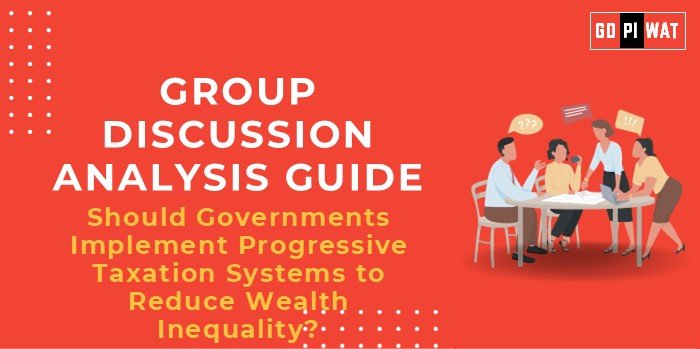📋 Group Discussion (GD) Analysis Guide: Should Governments Implement Progressive Taxation Systems to Reduce Wealth Inequality?
🌍 Introduction to the Topic
Opening Context: Progressive taxation, where tax rates increase with income, has been a cornerstone in wealth redistribution strategies globally. With rising wealth inequality, this system’s role in achieving economic fairness is a critical topic for discussion.
Topic Background: Originating in the 19th century as a response to industrial-era wealth concentration, progressive taxation aims to fund public services and reduce inequality. Recent debates question its efficacy amidst globalization and tax avoidance.
📊 Quick Facts and Key Statistics
- Gini Coefficient of Inequality: Global average at 0.38; India’s score stands at 0.48 (2023), indicating high inequality.
- OECD Data: Progressive tax rates contribute up to 50% of GDP in Scandinavian countries, reducing inequality substantially.
- Wealth Share: The top 1% controls over 40% of global wealth, emphasizing the need for redistributive measures.
- India’s Direct Tax Contribution: 54% of total revenue (2023), highlighting dependency on income-based taxes.
👥 Stakeholders and Their Roles
- Government: Enacts and monitors tax policies for equitable wealth distribution.
- Citizens: Comply with tax regulations and benefit from redistributed public resources.
- Private Sector: Influences tax policy through lobbying; contributes to public revenue.
- International Bodies: OECD and IMF set global tax policy norms to address avoidance.
🏆 Achievements and Challenges
✔️ Achievements:
- Reduced inequality in Nordic countries: Denmark’s Gini coefficient dropped to 0.27 due to high taxes.
- Revenue generation for social welfare: India raised ₹10.5 lakh crore in direct taxes (2023-24).
- Stimulated economic stability through government spending on infrastructure and education.
⚠️ Challenges:
- Tax Evasion: Global losses of $427 billion annually due to evasion.
- Economic Distortions: High taxes can deter investment or labor market participation.
- Implementation Inequality: Urban-rural income disparities complicate tax distribution.
🌐 Global Comparisons
Success: The U.S. reduced the middle-class burden through tax credits, while the EU’s tax evasion crackdown yielded $100 billion annually.
Case Study: India’s “Vivad Se Vishwas” tax dispute resolution increased compliance by 24%. Sweden’s progressive model funds universal healthcare effectively.
🛠️ Structured Arguments for Discussion
Supporting Stance:
“Progressive taxes empower governments to bridge economic gaps, as seen in Scandinavia.”
Opposing Stance:
“High tax rates disincentivize entrepreneurship and encourage capital flight.”
Balanced Perspective:
“While effective in reducing inequality, progressive taxes require complementary policies to curb evasion and maintain growth.”
✨ Effective Discussion Approaches
- Opening Approaches:
- Start with a global statistic on wealth inequality.
- Quote notable economists like Thomas Piketty on progressive taxation.
- Counter-Argument Handling:
- Cite successful tax reforms mitigating evasion.
- Discuss alternative redistribution policies like UBI (Universal Basic Income).
🔍 Strategic Analysis of Strengths and Weaknesses
- Strengths: Equitable revenue generation; reduced poverty rates.
- Weaknesses: Compliance challenges; economic distortions.
- Opportunities: Digital tracking to reduce evasion; global tax collaboration.
- Threats: Globalization-induced avoidance; political resistance.
📚 Connecting with B-School Applications
- Real-World Applications: Taxation models in projects on public finance or international trade.
- Sample Interview Questions:
- “How does progressive taxation impact consumer behavior?”
- “Evaluate India’s tax reforms in reducing inequality.”
- Insights for B-School Students:
- Learn from Nordic policy efficiency.
- Explore fintech in tax compliance innovations.


